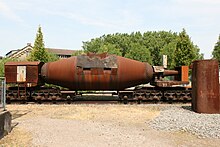Liquid metal transport
Liquid metal transport is the technical term in the foundry industry for the transport of molten metal not only within the plant, but over a longer distance to processing facilities outside of the smelter. The transport of the liquid is one of the temperature-controlled goods .
Mode of Transport
Rail transport
The first means of transport was the railroad using the torpedo ladle with a capacity of approx. 200 t, developed for the transport of liquid pig iron .
Road traffic
In the second half of the 20th century, rail-bound transport, which was limited to steel mill operations, was abandoned and road transport was developed. For safety reasons, aluminum and its common alloys were used . The aluminum is transported in molds . Liquid metal transport in road traffic is dangerous goods due to the dangers in the event of an accident . Warning signs have a thermometer in a red triangle as identification
For practical use, heavily insulated transport pans with a tightly closed lid were initially developed with a capacity of approx. 2.5 t of melt (approx. One cubic meter). Three such pans were picked up by a special vehicle with appropriate fastening devices for the pans. The transport pans now hold up to twice as much.
Transport routes
Based on experience gained about cooling the melt during transport, as well as safety in the event of accidents, the transport routes from the melting plant (mainly recycling huts ) to the foundry were gradually extended up to 200 km. The temperature drop in the melt was on average 10 K.
Extension of use
The mere delivery of liquid metal to the holding and casting furnaces of a foundry saved energy and thus costs; with a reliable delivery connection, a foundry connected to the system no longer required its own melting furnace. This also eliminated a number of official requirements that had to be met before a smelting plant was approved.
The transport ladle changes from the reusable transport vessel to the casting furnace
State-of-the-art technology is now a transport ladle, which is placed on a prepared foundation in the foundry, which also ensures heating and heat retention even during pauses in pouring. After the ladle has been emptied, it is lifted from the foundation using a crane and replaced by a full ladle delivered " just in time " by the recycling hut . The consequence of this development is that a foundry that has adapted to this no longer needs holding and casting furnaces and achieves further considerable cost advantages. The system is particularly advantageous for larger foundries that work continuously and have to produce large quantities.
literature
- Stephan Hasse (Ed.): Giesserei Lexikon. 17th edition, Schiele and Schön, Berlin 1997, ISBN 3-7949-0606-3 .
Footnotes
- ↑ here the expression liquid charging is used for a process step that has always been normal, namely when a larger melting furnace in continuous operation passes the melt on to downstream departments ( die casting , die casting , low-pressure casting ) with their numerous casting furnaces by transport crucible and forklift truck
- ↑ Example illustration
- ↑ Section 7.5.11 Special provision CV37 ADR
- ↑ (Hazardous goods label "Substances in a heated state" according to GGVSEB, Section 5.3.3 ADR, RID, IMDG, GGVSee and ADN) [1] [2]
- ^ Oetinger GmbH: Range of services . Retrieved February 3, 2012.


